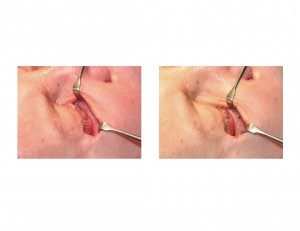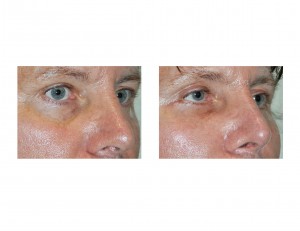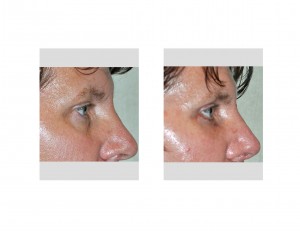Background: The shape of the eyes is determined by many anatomic factors including the amount of fat under the eyelid skin. One undesired aesthetic look of the eyes is a deep depression underneath it. Known as lower eyelid hollows, this is when the lower eyelid skin indents beneath the lashline and lower lid margin. This creates a shadowing effect which lends to a tired or aged appearance.
Lower eyelid hollows are a reflection of the underlying anatomy. It could be due to a natural lack (congenital) of or age-related atrophy of fat, a weak or deficient infraorbital bony rim, a bulging eye (rare) or some combination. The most common cause of lower eyelid hollows, however, is almost always skeletal-based due to the projection of the lower bony rim. Fat deficiency may also be present but is not often the sole source of the problem.
Treatment of lower eyelid hollows requires augmentation which can be done by two basic approaches. The non-surgical injection approach is the simplest using either synthetic (hyaluronic acid-based) fillers or fat injections. A trial with synthetuc fillers is a good first step to confirm whether any type of augmentation will be effective. Fat injections offer a potential long-term solution but there is the risk of lumps or irregularities and its retention is not completely assured. Implants of the infraorbital rim offer an assured permanent solution but it is a surgery that is very technique-sensitive.
Case Study: This 47 year-old male did not like the appearance of his lower eyes. He felt they were sunken in, particularly in the tear trough area. He was not interested in fat injections and had had a prior experience with an injectable filler that left him bruised and irregular over a year ago. He not only wanted the bony rim built up but also wanted some malar augmentation as well.



Case Highlights:
1) Tear troughs or lower eyelid hollows can be permanently improved by orbital rim implants.
2) Orbital rim implants are placed through a lower eyelid (blepharoplasty) incision.
3) Precise placement of the implants on the infraorbital rim and secured by small screws is necessary to prevent implant migration and edge palpability.
Dr. Barry Eppley
Indianapolis, Indiana


